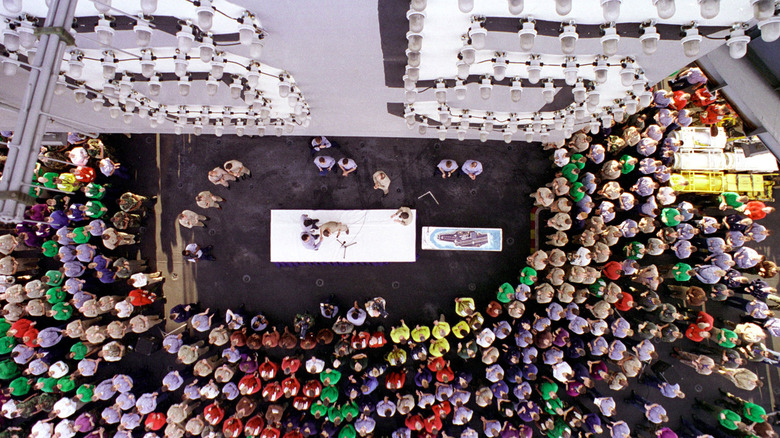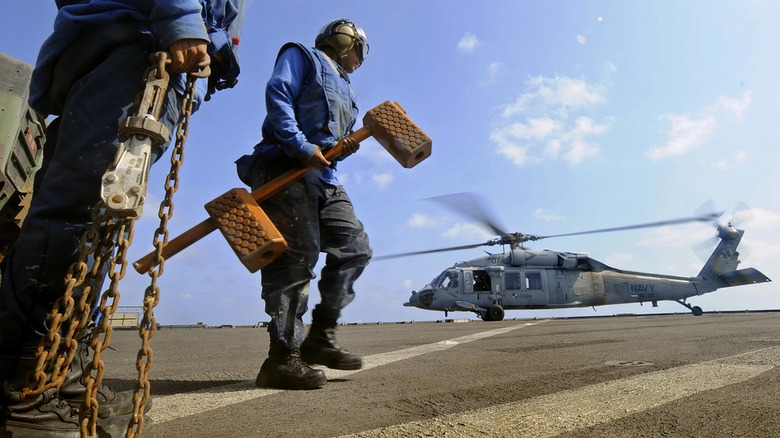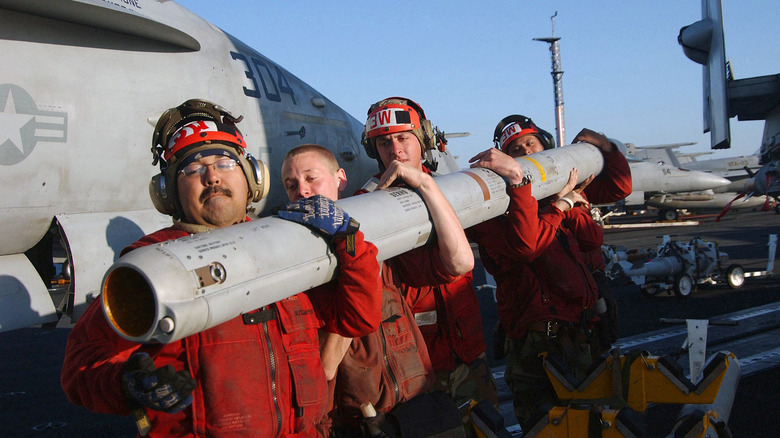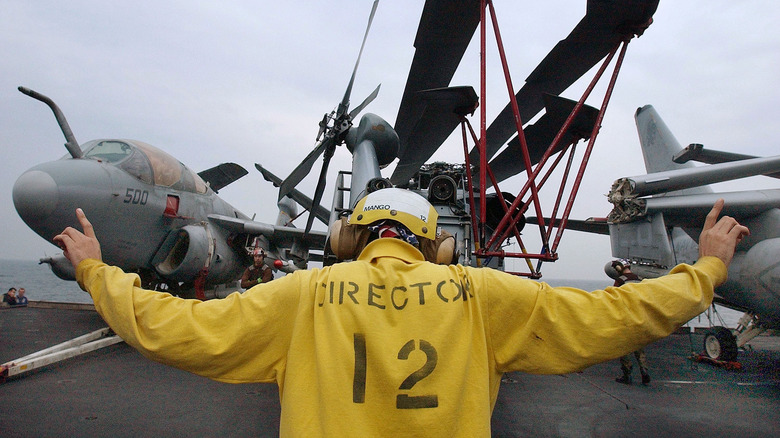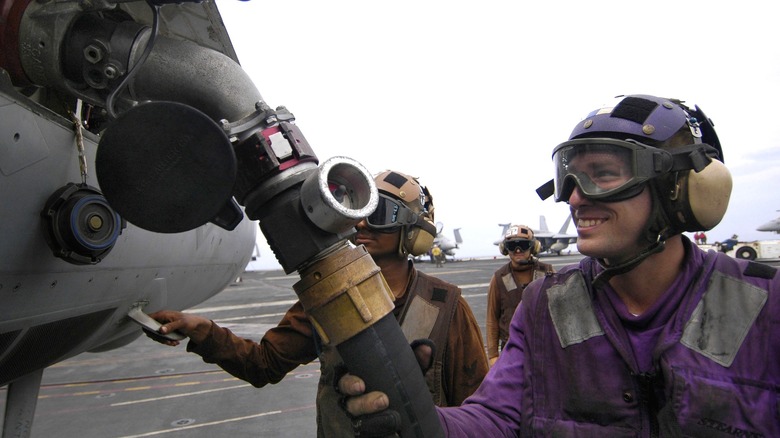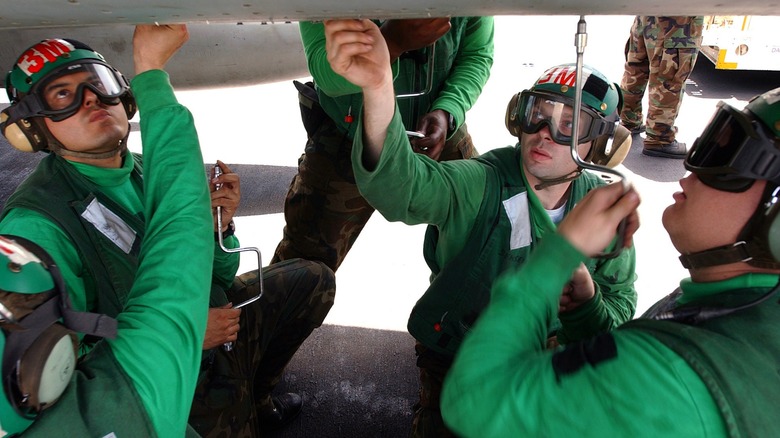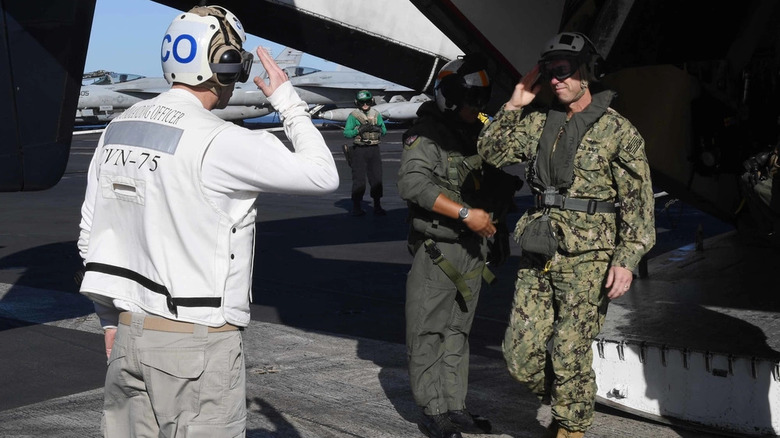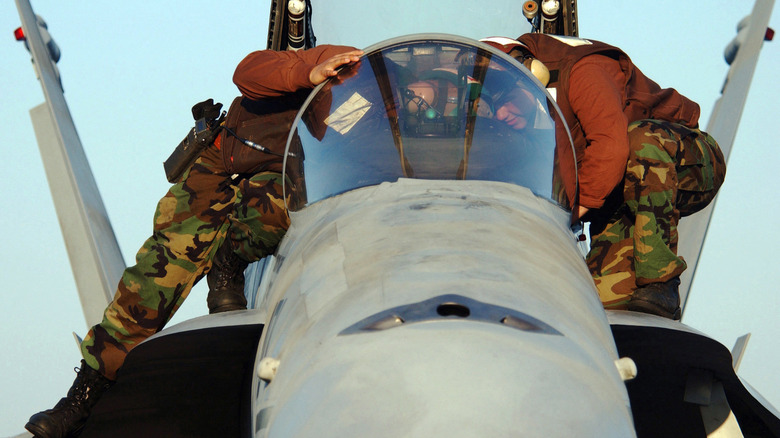Rainbow Spectrum: US Aircraft Carrier Crew Color-Coded Uniforms And What They Mean
Many of us imagine the military as a dour and serious place, concerned as it is with matters of warfare and defense. In that context, the colorful crew uniforms we see on U.S. aircraft carriers feel out of place. Their vivid blue, brown, green, purple, red, white, and yellow outfits contrast with the low-key, functional color schemes of aircraft carriers and the fighter planes they host.
Unsurprisingly, U.S. aircraft carrier crews aren't decked out in those fetching colors out of some fashionable impulse. Instead, it's a utilitarian gesture that facilitates the smooth operation of an aircraft carrier. The flight deck can be a crazy place, with what seems like a million different pieces — planes, people, equipment — moving all at once. So, the color-coded uniforms are an easy — to the trained eye, at least — way of identifying personnel roles at a glance. On large aircraft carriers like the USS Gerald R Ford, it's essential.
With the increasing complexity of naval warfare and the rise of the aircraft carrier, these uniforms don't just make it easy to identify roles in the chaos, but they also help Primary Flight Control manage and organize everything that happens on deck, even in the toughest conditions. But while the colors may be obvious to those in the know, it's not necessarily an intuitive system, leaving most of us outsiders in the dark. Thankfully, none of this information is secret, so we can help shed some light on the colorful world of U.S. aircraft carrier crew uniforms.
Blue
Blue uniforms are part of a three-color combo responsible for aircraft handling on board the aircraft carrier, with the other two being yellow and red uniforms. Navy personnel going down the Aviation Boatswain's Mate, Aircraft Handling (ABH) career path start out wearing blue uniforms, where they're responsible for immobilizing planes and ensuring that aircraft are securely attached when they're not in flight. To do this, they run around and chase tires — in the Navy's parlance — on deck, chocking and chaining aircraft tires to ensure they don't roll around with the ship's movement.
Blue-uniformed personnel also operate the motorized equipment necessary to move planes and cargo around the carrier's flight deck, including forklifts and tractors — the latter of which also help fuel airplane engines. They also handle the carrier's aircraft elevators — high-speed hydraulic platforms that move planes from the hangar where they're stored, to the flight deck for takeoff.
Out of all the personnel you'll see onboard a U.S. aircraft carrier, blue shirts will be the most prominent. Once a blue shirt has gained enough experience, they can continue on the aircraft handling career path, donning either a yellow or red uniform, depending on their preference.
Red
One of the blue-red-yellow trio of ABH sailors aboard an aircraft carrier — and one of the two options for experienced blue shirts looking to move up the ranks — red shirts handle two important and dangerous responsibilities on all U.S. aircraft carriers.
Firstly, red shirts are ordnancemen, responsible for arming planes with all the ammunition, bombs, missiles, and mines they need for any given combat mission — including nuclear bombs on a nuclear-capable fighter plane if that ever becomes necessary. They also store, maintain, and transport these munitions, moving them between storage and the fighter jets or attack helicopters that need them, courtesy of dedicated elevators. Some of these missiles, like the Advanced Medium-Range Air-to-Air Missile (AMRAAM ), can weigh more than 300 pounds, making this one of the more back-breaking tasks on an aircraft carrier.
However, red shirts aren't all about combat: They also have a crucial role to play in ensuring the safety of the aircraft carrier and all hands on board. Red-uniformed sailors are responsible for explosive ordnance disposal (EOD) and also form the crash and salvage crews on a carrier, where they're tasked with firefighting and rescue work — complete with surprisingly cute shipboard firetrucks — in the case of a fire or accident.
Yellow
Of all the roles on board a U.S. aircraft carrier, the yellow shirts are one of the most specialized and prestigious. Yellow shirts have only one task, but it's arguably the most important of them all: they direct and manage all aircraft movement on the carrier, be it on the flight deck or in the hangar.
Unlike most other crew roles, sailors with yellow uniforms don't just work on deck. While you can often spot yellow shirts amid all the chaos on deck, selected yellow shirts also sit in a carrier's primary flight control (also known as Pri-Fly) and take up the roles of "Air Boss" and "Mini-Boss." This is where they help manage and organize plane movements, taking direct responsibility for the aircraft and their pilots by ensuring that no planes collide while on the carrier or within a 5-mile radius.
They also serve as officers for the catapult and arresting gear on deck. It's a highly demanding role, with sailors having to earn the right to don a yellow shirt through a lot of training and several qualifications — and many hours spent in a blue uniform chasing after planes and chocking their wheels. These rigorous requirements also mean that yellow shirts don't display their rank, as it's less important. This makes the yellow shirts the only personnel who don't do so on board an aircraft carrier.
Purple
Purple-clad sailors are one of the few on board a U.S. aircraft carrier with only one role, being even more specialized than the yellow shirts. Purple shirts are responsible for all fuel onboard a carrier, making sure that every aircraft and vehicle is ready to go when needed.
Given how important fuel is to every combustion-powered engine out there, plus how dangerous and flammable it is, it makes sense that aircraft carriers have sailors dedicated to handling the all-important liquid and nothing else. Purple shirts — affectionately known as "grapes" in the U.S. Navy — fuel and de-fuel all the planes on board with the JP-5 jet fuel they require, which is a high flash point kerosene that fulfills the U.S. Military's specifications.
Grapes do more than fill up fighter jets, however. Below deck, they also oversee the entire fueling process on board an aircraft carrier. They handle the underway replenishment of an aircraft carrier's fuel supplies, refine the dirty fuel by removing all the water and sediment, inspect the fuel before refueling, and maintain and service all the equipment involved in the entire process.
Grapes also work hand-in-hand with the red shirts by training and directing the carrier's firefighting and rescue teams.
Green
If purple shirts are one of the most specific roles on board a U.S. aircraft carrier, then green shirts are almost entirely the opposite. These crew members serve a variety of roles on board, although their main task primarily involves the maintenance of most of the carrier's on-deck equipment.
Green shirts operate and maintain the catapult and arresting gear, which help launch and stop aircraft on takeoff and landing, respectively. The latter includes the dangerous task of being a hook runner, which involves running up to a recently landed plane and freeing any parallel arresting cables caught in a plane's tailhook. Catching one or more of these cables with the tailhook is what helps stop a plane when it lands, so freeing them is necessary so that they can help stop the next plane that flies in.
Other tasks assigned to green-shirted sailors include looking after and working on aircraft — including fearsome fighter jets like the Boeing F/A-18E/F Super Hornet — troubleshooting ground support equipment, handling cargo, and communications tasks (specifically, serving as photographer's mates). Landing Signal Enlisted sailors tasked with signaling helicopters for takeoff and landing also wear green outfits.
White
White shirts rival green shirts in terms of the sheer variety of tasks, and like the green shirts most of their tasks revolve around one central responsibility. In white-uniformed sailors' case, it's security and safety. Medical personnel on board aircraft carriers wear white uniforms, as do those tasked with general safety.
The latter involves several more specific tasks, including quality control and assurance of equipment such as the catapult and arresting gear. Quality assurance and squadron plane inspector leading petty officers wear white, as do safety observers and liquid oxygen (LOX) crews. LOX is essential for high-altitude flying, and the LOX crews ensure that all planes have the liquid oxygen necessary to last the length of their mission.
Other roles decked out in white shirts include landing signal officers — who monitor and talk down all aircraft approaching a carrier — and air transfer officers, who help facilitate the arrival of new personnel, mail, supplies, and cargo. The latter is an essential part of life on an aircraft carrier, as while the ships themselves can go ages without refueling, the crew members aren't nearly as durable. White shirts are also worn by an aircraft carrier's administrative personnel.
Visitors on board an aircraft carrier will be greeted by a sailor in white, usually accompanied by a yellow shirt.
Brown
Brown uniforms denote air wing plane captains, which is the Navy's way of saying that these sailors oversee the aircraft on board a carrier. Their dedicated task reflects its importance: With planes like the Boeing F/A-18E/F Super Hornet — one of the most advanced fighter jets currently flying — costing the U.S. government around $64 million each, it's vital to make sure that all the aircraft on board are in great shape and ready to go at all times.
The role of brown shirts complements that of yellow and green shirts. They supervise the maintenance, launch, and recovery of the aircraft on board a carrier. Brown shirts are also responsible for pre- and post-flight preparation and checks, ensuring that all planes are safe to fly, often within strict time limits. Plane captains also communicate directly with the pilots, staying with the plane all the way until it takes off from the flight deck.
Brown shirts also jump in the cockpit of a plane when the crew repositions one on the flight deck or in the hangar, giving them the nickname "brake riders." Line leading petty officers, responsible for leading personnel, also wear brown uniforms.
